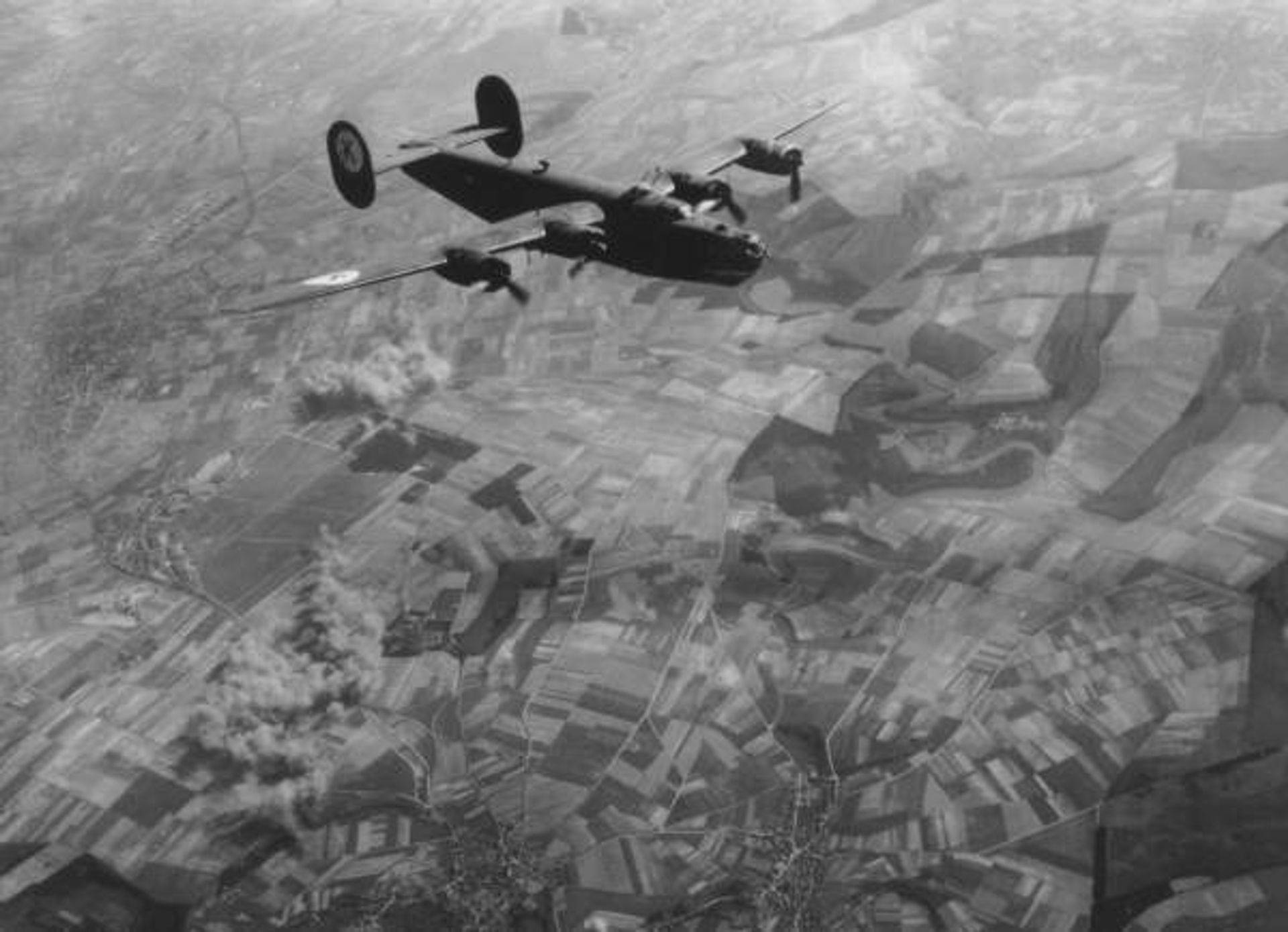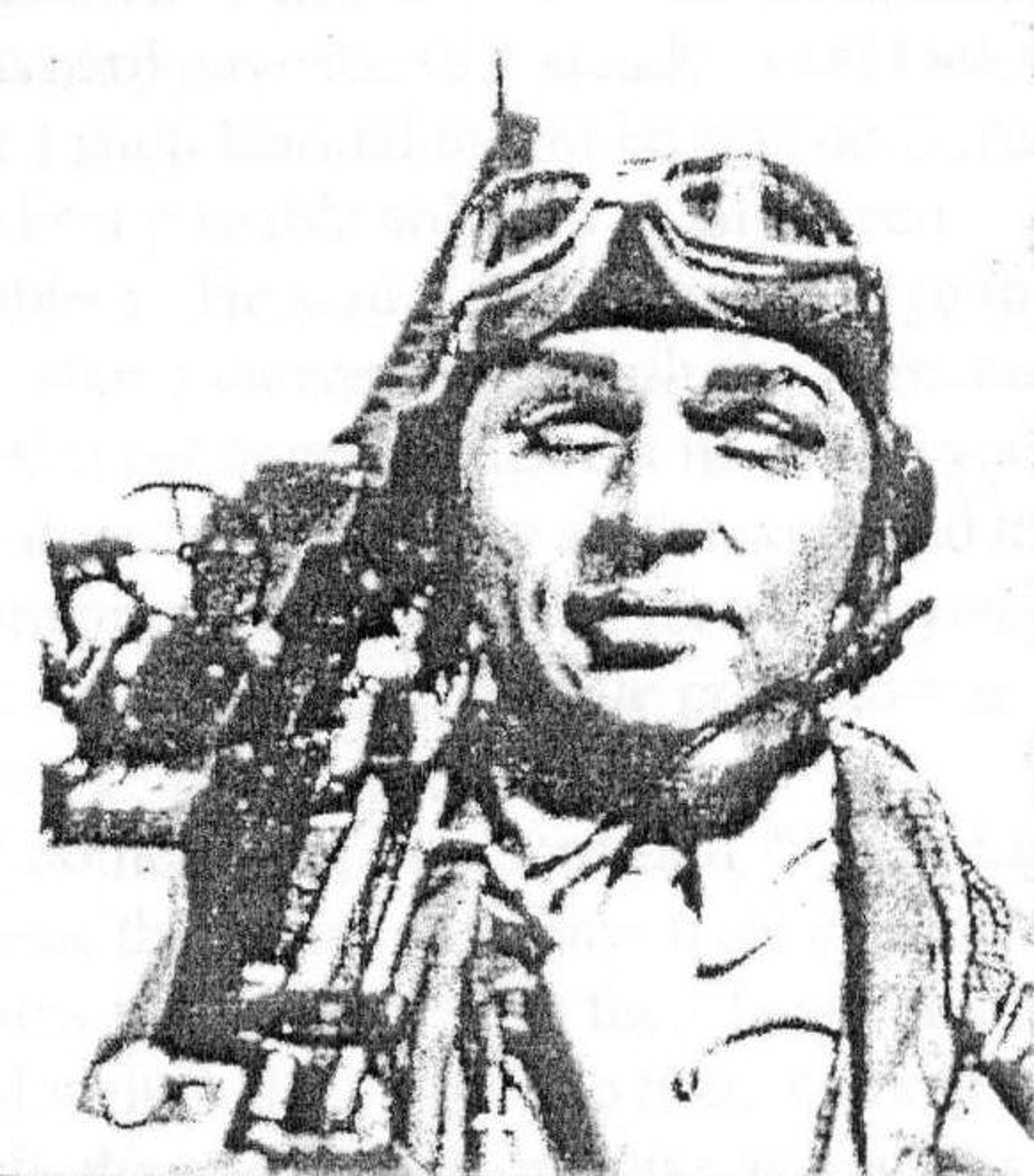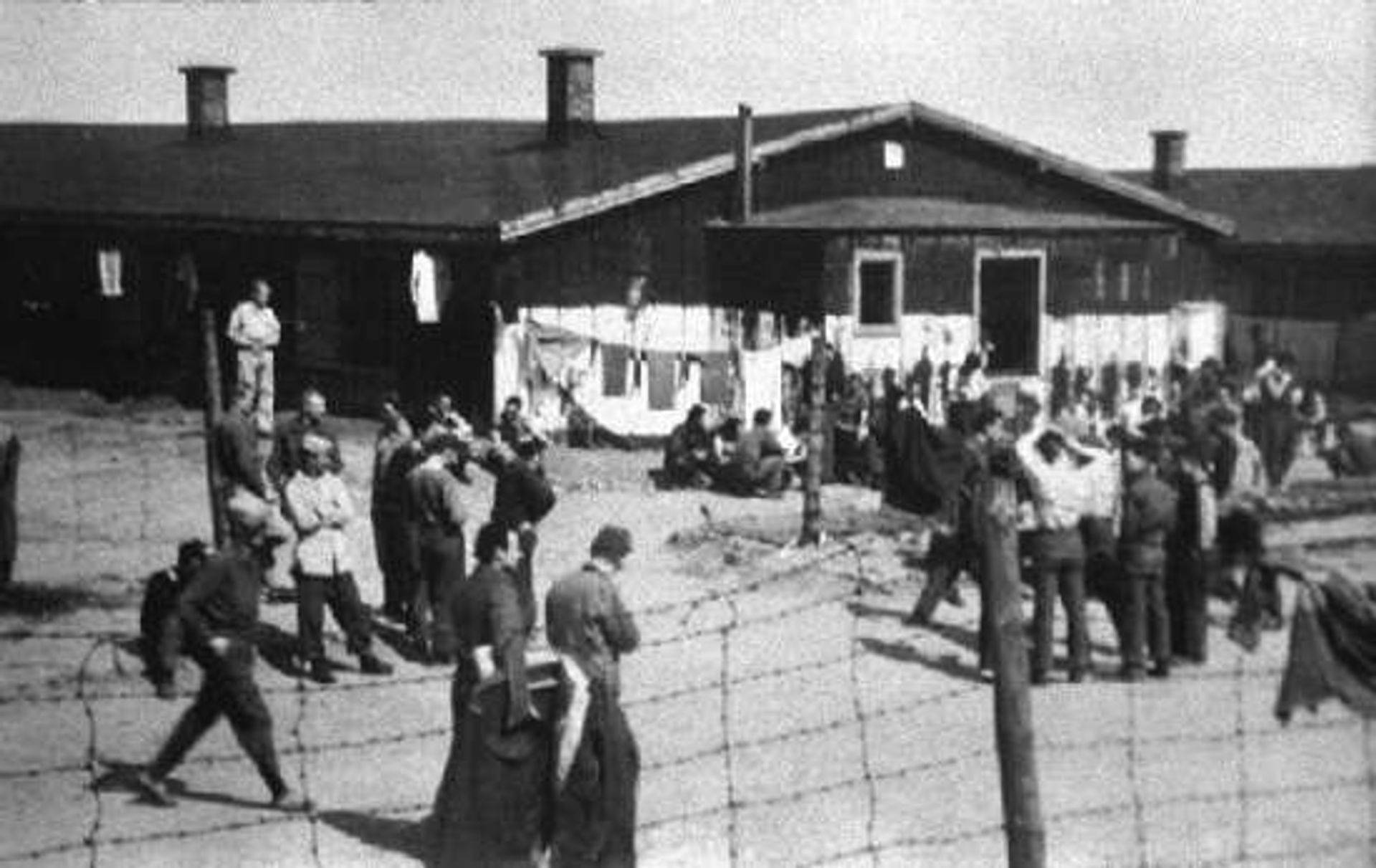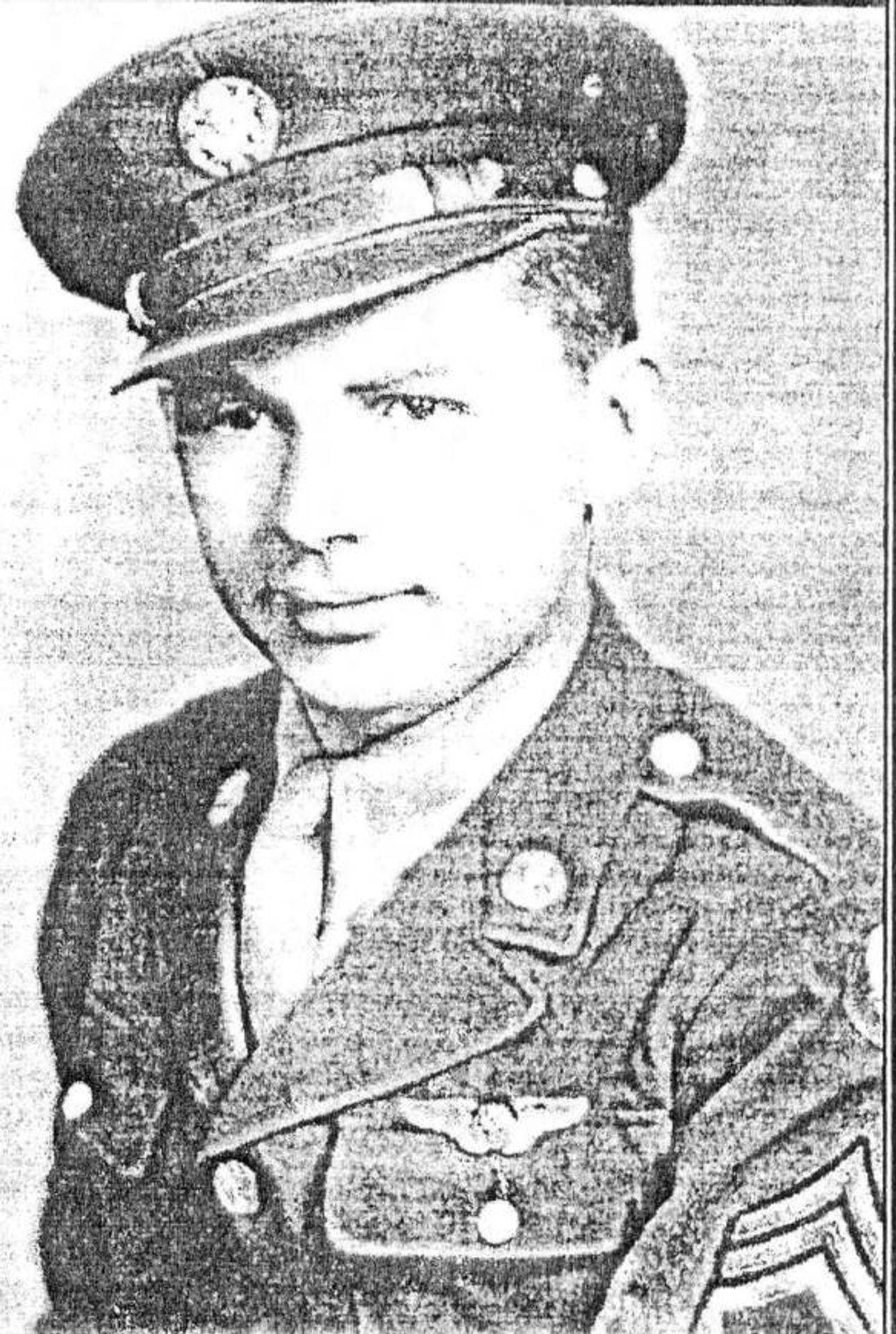458th Bombardment Group (H)
The Blanket
A Miracle in the Making

Early Spring 1944: Flak Magnet over the target
(Photo: David Manker)
It was the first week of May 1944 and the group of American Army Air Force prisoners of war that I was a part of had just been processed into our ‘permanent’ prisoner of war camp. Unfortunately, that POW camp was the infamous Stalag XVII-B near Krems, Austria, later to be glorified in the movie “Stalag 17”. We had all just been through the weeks of trauma that usually accompanied becoming a prisoner – parachuting from a burning plane or crash landing into German-held Europe. In our case it had been the burning airplane.
We were Crew 33, 458th Bomb Group, Second Air Division, Eighth Air Force. Our B-24 Liberator “Flak Magnet” had taken a hit from heavy flak during the bomb run on military targets at Hamm, Germany. Following the many daily interrogations by German intelligence officers, threats of firing squad, solitary confinement, little or nothing to eat, and the long train ride packed into cattle cars from Frankfurt to Krems, Austria, at last we were there.
Our crew chief [flight engineer], Jim Wedding and I had been assigned to the same eight-man bunk in Barracks 30B in the ‘new compound’ next to the Russian half of the camp. We had gone through the delouser together. That was where a Frenchman with sheep shears took off any hair you still had, your clothing was hung on hooks to go through a fumigation room to kill any body lice or fleas. At the same time, in groups we entered a shower room to scrub down with lye soap. Of course, when you first entered that shower room, almost to a man, the first quick look was to see if those were shower heads or gas jets along the walls. We had all heard early reports of the gas chambers at Auschwitz and Belsen, so there was considerable apprehension.

S/Sgt Cedric Cole and T/Sgt Jim Wedding – Tonopah, Nevada 1943
After processing by the Germans we were all herded into the camp ‘theater’ for what was really a rousing reception and welcome from all those old “Kriegies”, most of whom had been prisoners for many months or years. (Kriegsgefangener is the German word for Prisoner of War). We held those old-timers in awe. They had survived some of the worst days of the war, had all come from other prison camps when Stalag 17 had opened, and had experienced things we could only imagine.
The Germans had complied with the Geneva Convention… in their own way. We were issued a mattress and two blankets. The mattress was a burlap bag filled with about a bushel of wood shavings or ‘excelsior’ as it is called. Those wood shavings quickly turned to dust and fell through the bag… And the blankets were small, very thin and full of holes. It also turned out that, other than two or three weeks in August, it was cold. No heat in any of the buildings, snow blew in through cracks in the walls… the chill permeated your bones and you knew that you would never, ever be really warm again.
Right from the start there were a lot of reunions taking place among the prisoners. New arrivals were re-contacting crew members who had become separated, old Kregies finding newcomers from their hometowns or their old bomb group. It was all done by word of mouth. You heard of someone in one of the other barracks and went looking and asking. And that was how I met one of the most memorable people I have ever known. We had been there a few weeks when one of the old Kriegies came looking for me. He had heard there was a fellow in Bks 30B from his hometown of Kankakee, Illinois. That was how I met Maynard B. Standley. We hit it off immediately. He was obviously a considerate, understanding, thoughtful man of great wisdom and maturity. At the time I thought he was much older that I, only later learning that he was almost exactly one year older. But far older in wisdom, wit, responsibility, and well thought out answers to all of life’s problems.

S/Sgt Maynard B. Standley – B-17 gunner, 306BG – 1942
As the weeks and months went by, we regularly visited back and forth; he would come up to our barracks once or twice a week and I would trudge to his barracks, 39B down at the far end of the camp. He was, it turned out, “camp security man” and one of the key players in the events depicted in the movie “Stalag 17” many years later. Early on, his common sense and considered judgment were evident.
One day we were discussing the standard daily ration issued from the camp kitchen. During the times of relative abundance, each barracks received 8 loaves of ‘ersatz’ bread. It was very dark brown, rather heavy, and made from a mixture of wheat hulls and wood pulp that had been chemically broken down. There were occasional rather large chunks of wood in the bread, some that hadn’t been fully dissolved. With about 165 prisoners in each barracks, that came out to about 1/8 loaf of bread per man, per day. Each noon every barracks sent a 4-man detail to the camp kitchen to bring back a wooden tub full of soup. It was mostly fluid with a few chunks of rutabaga tops, stems and leaves. Not bad really – if you were hungry enough…but it always had a lot of little maggot-type worms in it. If you attempted to flip those worms out with your one issued pot-metal spoon, the result was very little soup left in your tin can bowl. When we were discussing that, Maynard gave me that steady, level look, the one I soon learned meant he was delivering the best possible solution to any given problem. He said, “C.C., when you go to eat, start a conversation with Jim here, don’t look at the soup…just eat it. When you get done you will have all the soup and that extra protein will be good for you anyway.” He was right, and that little problem was solved.
Another time, Maynard said, “Don’t be one of those that withdraw from everything. A few just give up, turn their face to the wall and wait to die. Don’t do that. Get out and walk the compound, exercise as much as you can, read all the books you can get your hands on, take classes.” Again, he was right. Jim and I enrolled in a 13-week Business Law class, taught by a prisoner-volunteer who had been a Connecticut patent attorney. Later we took a 13-week course in spoken French. They were both great classes of lasting value to us. We walked the compound numerous times each day and it was out there that I discovered that my old buddy Jim Wedding had an amazing talent. He could go the 120 yards or so around that compound, sometimes several times…walking on his hands all the way. Every time I tried it, I lost my balance and toppled over in a few feet.

Daily life at Stalag XVIIb – Krems, Austria
One of the first things that struck me about the old Kriegies was the great difference in appearance from our group. A few weeks after our arrival, I just had to ask Maynard about that, but didn’t quite know how. Hesitantly, I said, “Maynard, I don’t know how different the guys down in your barracks all look…uh…” Standley broke in, again with that steady, level look, and said, “You mean that our skin has sort of a dull, grey look; there is no real expression on our face…sort of like there’s nobody home inside; that when we look at you it isn’t really at you, but more through you?” It was uncanny, almost eerie, as if Maynard had looked inside my head and read the unspoken words. “Yes, that’s it!” I said, relieved that he had understood so quickly. That level look with just the hint of a grin and Standley said, “Think nothing of it C.C. In a couple of months we’ll all look the same.” Of course, once again he was right.
Starting a month or so after our arrival at Stalag 17, every few weeks and lasting for several days each time, I began getting spells of violent chills, shivering and trembling and all the while burning with fever. Maynard was visiting during one of those spells and was very concerned. He said, “C.C., you’ll never make it when it gets really cold this winter. You’ve got to have something to keep you warmer.” While visiting Maynard at his barracks, I had many times seen and admired his own creation. It was a half-inch thick wool mat woven from the remnants of hundreds of pairs of discarded worn-out socks. He had amassed many large balls of various colored wool yarn. From other prisoners, from the trash piles, any time he could get his hands on discarded socks, no matter how worn, he gathered them. After careful washing he would cut off the worn foot part, then carefully unravel the tops and roll the yarn into balls.
He said that when he started he knew the yarn could be used but didn’t know how. After studying the idea for some time, he had decided to devise a makeshift loom. Somewhere he had gotten a piece of 1’ x 4’ board about 30 inches long. Using a nail he had pulled from a wall and a lot of patience, he made rows of holes in that board. Then, with an old razor blade he had whittled out dozens of little wooden pegs to fit those holes. With a little trial and error, he had learned to weave. His creation was not a blanket. His wool mat was to sleep on, and to pad the 1 X 6” boards that made up our bunks, based on the reality that much of the cold that attacks a sleeper comes from the bottom, not the top. He had even used the various colors of yarn to turn his creation into a thing of considerable beauty. Standley always adhered to the adage that if something is worth doing it is worth doing well.
At this point, Maynard suggested that Jim and I make our own blanket. We all quickly agreed that weaving a blanket large enough for two people was out of the question. Not just that it would consume more yarn that we could hope to salvage in a few months. But even as fast as Maynard’s fingers flew when weaving, it was a painfully slow process. Then Maynard suggested, “Why not make the blanket out of discarded trousers?” He said that he would get us started with a good supply that he had collected over those long months…he always saved anything that might be of future value. And worn out trousers were to be found on the trash piles. We all agreed, that could be a solution, particularly after Maynard revealed that he had a large needle that we could use and that some of his yarn could be used to sew the blanket together.
Once we started scrounging the camp for discarded trousers it was amazing how many we found. Some so worn out that only a few squares of cloth could be saved. We had determined right off that to be able to fit all the pieces together we would need to cut the material into standard sized pieces…maybe keeping smaller bits of fabric for last-resort necessity. We were surprised at the variety of colors and textures that turned up. Not just American GI olive drab. There were some Serb and/or Italian uniform parts that were rich, heavy gray flannel; dark blue, tan…parts of American, German, Serb, British, French, Italian and other uniform pants that had been discarded. A United Nations of wool trouser remnants!
We immediately all agreed to assemble that variety into a creation of aesthetic appeal as well as utility. And almost as immediately hit our first snag. Just how do you sew 6” by 10” pieces of heavy material together with sock yarn? The only way we could come up with was to lay one piece on top of another and just go in and out along one edge, pulling the thread as tight as possible, tying it off each few inches, and just keep adding pieces.
As the blanket began to take shape over those weeks and months, we all got caught up in a creative fervor. Other POW’s began coming around to check the progress, many bringing material they had ran upon. At a time and place where mostly each day was a replica of the one before, that blanket almost took on a life of its own. And as it grew, so did our ambitions. At first we had planned it to be barely large enough to cover our bunk. But around the middle of October when we trimmed off the outer edges with doubled over pieces to give it a finished look, the blanket had grown. Finished, it was more than eight feet wide and ten feet long. Of course, we had begun using it as it grew, but the finished creation was just in time for really cold weather.
Even then we realized that we owed a lot to that blanket and even more to Maynard for all his assistance and encouragement. Not only did the blanket keep us warm during those bitter, long nights of that last desperate winter, creating it had occupied us for many months. It had taken our minds off our situation…gave us purpose and a sense of accomplishment. Maynard Standley, Jim Wedding and I were proud of what we had created. We felt that it was our own little miracle. We knew that, for the conditions, it was a masterpiece and should someday rest in a prisoner of war museum.
That never happened. When the Germans marched us out of there in April 1945 as the Russian armored columns neared the camp, reluctantly we left our blanket behind. There was no choice. We had been starved to less than a hundred pounds, our feet had frostbite, and just walking was painful. On that long trek to Braunau and eventual liberation, we could barely carry ourselves, much less a 10 or 12 pound blanket.

EPILOGUE: Jim Wedding and I have stayed in touch over the years, and with survivors of Crew 33 we held reunions in 1985 and 1986. Jim and Elaine then lived in Peachtree City, Georgia. I now live in southern Illinois. I lost track of Maynard in the late 1940’s, knowing only that he and his wife had moved to Oregon. For years I searched membership rosters of the American Ex-POW’s and the Stalag 17 Associations. He was never listed until the 1995 Stalag 17 Association roster arrived. The computer age must have finally caught up. That time he was listed. He had died May 5, 1993. Maynard and his wife, Alice, had three children. Alice Standley lives in Pendleton, Oregon as does their son, Richard. Daughter, Paula Jo lives in Longview, Washington and son David in Geneseo, Illinois. Jim and I know they are proud of their husband and father. We will never forget all his steadfast kindness did for us. Maynard B. Standley was one of a kind…And for us he truly did have an answer to each of life’s problems.
Maynard Bourn Standley
July 4, 1921 – May 5, 1993
Soldier, Craftsman, Volunteer, Husband, Father – American
In All That He Did, He Did It Well
Cedric Cole, courtesy his daughter Sue Knepper
